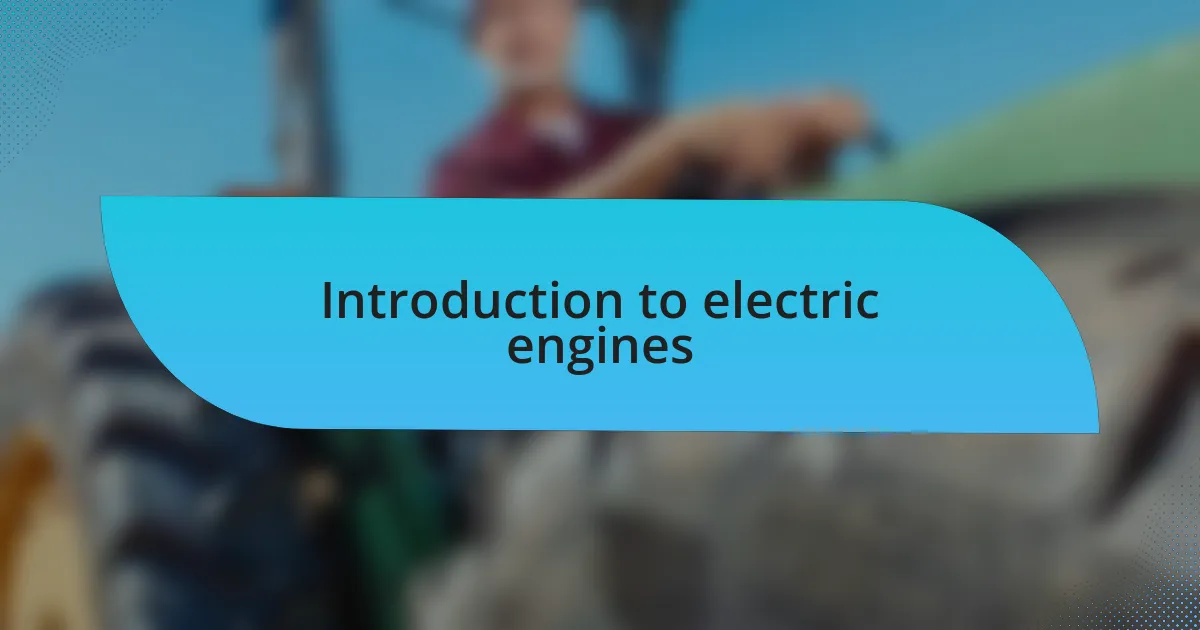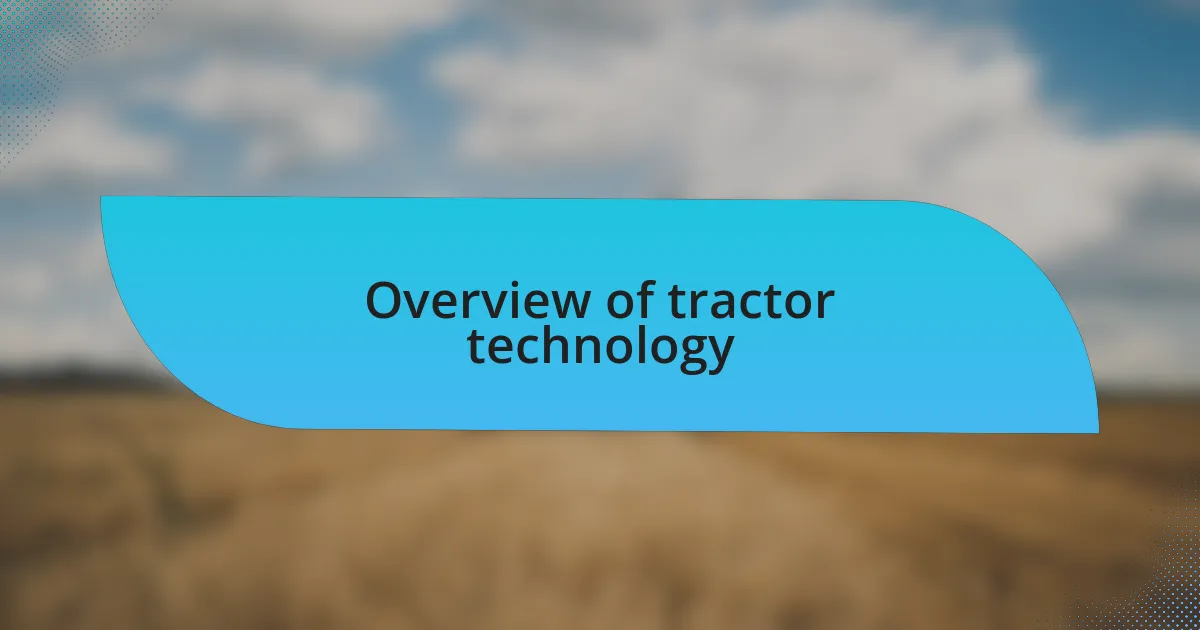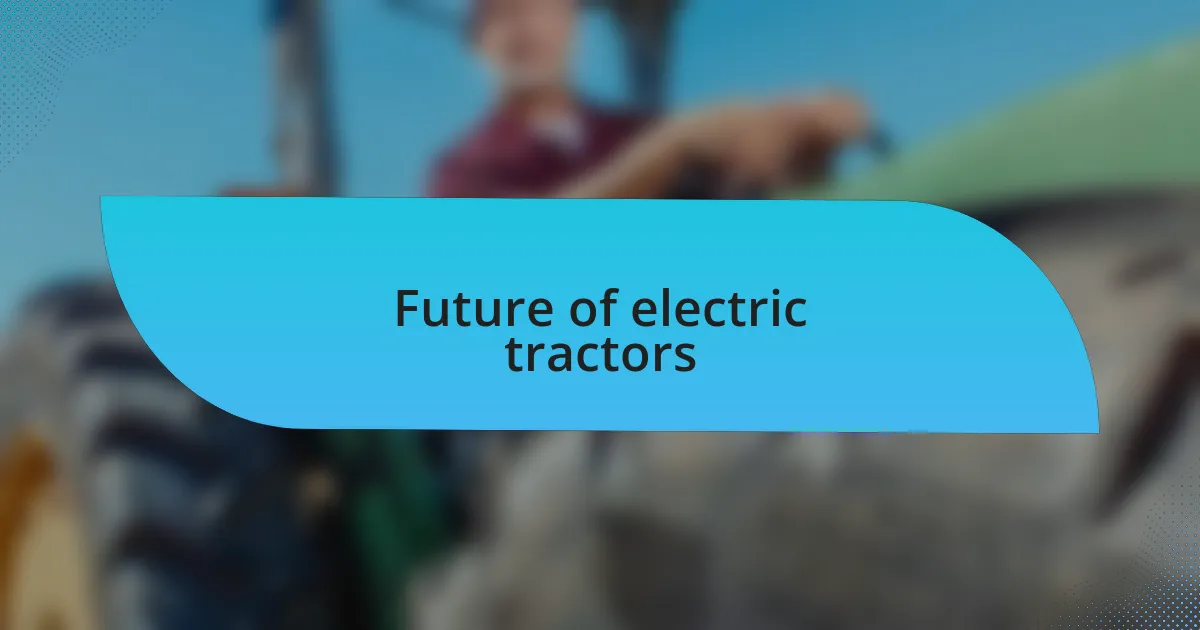Key takeaways:
- Electric engines in agriculture enhance efficiency, reduce operational costs, and lower carbon footprints compared to traditional engines.
- Conversion to electric engines significantly decreases noise pollution and fosters a more serene working environment, improving teamwork.
- Successful tractor conversions involve thorough planning, selecting compatible parts, and careful installation, emphasizing the importance of precision and problem-solving.
- The future of electric tractors is bright, with potential advancements in battery technology and the integration of solar power for sustainable farming practices.

Introduction to electric engines
Electric engines have become a game changer in the realm of machinery, particularly in agriculture. I still remember the first time I saw an electric tractor at a local farm show—it was eerily quiet yet powerful, challenging my preconceived notions about tractor performance. As I stood there, I couldn’t help but wonder: could this technology revolutionize how we think about farm equipment?
One compelling aspect of electric engines is their efficiency. Unlike traditional internal combustion engines, electric motors convert a higher percentage of energy from the battery into usable power. This makes them not only more efficient but also potentially more cost-effective over time. Isn’t it fascinating to think how reducing fuel costs can also minimize our carbon footprint?
The simplicity of electric engines is another point that catches my attention. Fewer moving parts translate to lower maintenance requirements, which can be a boon for farmers dealing with tight schedules. I once spoke to a farmer who swapped his diesel engine for an electric one; he expressed how it not only saved him money but also provided a sense of satisfaction—doing his part for sustainability while boosting productivity. The convergence of technology and ecological responsibility opens the floor to numerous exciting possibilities in our industry.

Benefits of electric engine conversions
When considering electric engine conversions, one cannot overlook the sheer reduction in operational costs. Having talked to various farmers who’ve made the switch, many mentioned that their electricity expenses fall well below what they previously spent on diesel fuel. Isn’t it refreshing to think of a farming future where the bottom line improves just by choosing a different power source?
Another notable advantage I’ve observed is the dramatic decrease in noise pollution. I remember visiting a farm where they had converted their tractors to electric. The tranquility was astounding; the quiet hum of the electric motor allowed for a more peaceful working environment. It also made conversations easier among the workers, fostering better teamwork and communication on-site. Who wouldn’t prefer working in a serene atmosphere rather than the incessant roar of traditional engines?
Moreover, electric engine conversions significantly contribute to sustainability. Reflecting on my experiences at farm expos, I often hear attendees express a sense of pride when discussing their investment in eco-friendly technologies. One farmer shared how his shift not only minimized his carbon footprint but also attracted environmentally-conscious customers. Isn’t it remarkable how a single decision can create ripples that enhance both personal and community values?

Overview of tractor technology
Tractor technology has evolved significantly over the years, morphing from simple mechanical machines into sophisticated systems integrated with advanced electronics. I’ve seen firsthand how modern tractors utilize precision farming techniques, which optimize productivity through GPS-guided systems. It’s fascinating to think about how technology has not only transformed the way we farm but also enhanced the efficiency of our operations.
One key aspect that stands out to me is the role of automation in modern tractors. Many of them come equipped with features like automatic steering and yield mapping, which allows farmers to focus on strategizing rather than just driving. I recall attending a workshop where a farmer demonstrated how automation reduced his daily workload, freeing up time for other essential tasks. Isn’t it incredible to think how these enhancements can revolutionize the farming experience?
Additionally, the rise of connectivity in tractors has brought about a new level of insight and control for farmers. With data analytics, operators can track everything from soil health to equipment performance in real-time. I was amazed when a colleague shared how he uses mobile apps to monitor his fleet remotely. This level of engagement not only saves time but also fosters a deeper understanding of the farming ecosystem. How can we ignore the potential of technology to reshape agriculture for the better?

Key components of tractor conversions
When diving into tractor conversions, several key components play pivotal roles in ensuring a successful transformation. One of the most critical elements is the electric motor, which replaces the traditional internal combustion engine. I remember feeling awed the first time I experienced the instant torque and smooth operation of an electric motor in a converted tractor; it’s like the machine just wakes up and responds instantly. Isn’t it remarkable how something so fundamental can change the entire operation of our equipment?
Next, the battery system is equally essential, as it determines how long the tractor can function without needing a recharge. I’ve seen different setups, from small batteries suited for light tasks to larger ones designed for heavy-duty work. This variability highlights a fundamental question: how do we balance power needs with efficiency? In my experience, selecting the right battery not only impacts performance but also affects how farmers plan their workdays.
Another component to consider is the conversion kit itself, which often includes wiring harnesses, control systems, and sometimes even adapters for compatibility with existing tractor features. The first time I installed a kit, it felt like piecing together a complex puzzle. Each part had its place and purpose, and when it all came together, I experienced a gratifying sense of accomplishment. It made me realize that these conversions are not just technical changes; they symbolize a shift toward sustainability in farming. How do we ensure these systems match our vision for the future of agriculture?

Steps for successful engine conversion
When it comes to a successful engine conversion, the first step is thorough planning and research. I vividly recall poring over manuals and online forums before starting my own project; it felt almost like preparing for a big exam. Why is this initial step so crucial? Simply put, understanding the specifics of both the tractor and the electric components lays a solid foundation for a smooth transition.
Once I’ve gathered all necessary information, the next phase involves carefully selecting compatible parts. I remember spending hours comparing different electric motors and battery packs, feeling both excited and daunted by the options available. This part of the process requires a keen eye, as the right combination can mean the difference between a well-functioning tractor and one that’s fraught with issues. It begs the question: how can we ensure that we not only choose what’s popular but what’s genuinely right for our specific needs?
Finally, installation is where the magic happens, but it’s also where patience is paramount. I’ve had my share of moments where a small mistake led to big headaches, reminding me that precision is key. Reflecting on those times, I ask myself: how much more rewarding is it when we take the time to do it correctly? Each carefully placed wire and fastened bolt builds not just a machine, but a testament to innovation in agricultural technology.

Personal experiences with conversions
Throughout my journey with electric engine conversions, I’ve experienced a real mix of emotions—everything from exhilaration to sheer frustration. I remember the day I finally flipped the switch and powered up my converted tractor. My heart raced as I realized the silent hum of the electric motor was not just a dream but a reality. Was it worth all the late nights spent troubleshooting? Absolutely. That moment reaffirmed why I embarked on this project in the first place.
There were times, however, when the challenges felt overwhelming. I vividly recall struggling to fit the battery pack in the confined space of my tractor’s chassis. It often made me question my whole approach, wondering if I was in over my head. Yet, this struggle became part of the learning process, teaching me invaluable lessons about problem-solving and persistence. Isn’t it fascinating how obstacles can turn into stepping stones?
The pride I felt driving my newly converted tractor around the farm is hard to put into words. It wasn’t just a machine—it became a symbol of my dedication and innovation. I realized then that these conversions are not merely technical projects; they reflect our passion for sustainability and progress in farming. How amazing is it to see technology blend with tradition? It truly represents a step forward for both us and the planet.

Future of electric tractors
The future of electric tractors is incredibly promising, and my enthusiasm for this evolution can’t be understated. I often envision farms powered by electric machines, working silently and efficiently while drastically cutting down on emissions. Imagine standing in a field, the only sound being the gentle hum of the electric motor—how much more peaceful and connected to nature would that feel?
While participating in forums about electric tractors, I’ve heard stories of farmers successfully incorporating solar panels to charge their machines. This synergy of solar and electric power not only reduces operating costs but brings about a sense of energy independence. Isn’t it thrilling to think that one day, our fields could be entirely self-sustaining, harnessing the sun’s energy to fuel the work we love?
As electric tractors become more mainstream, technological advancements will continue to enhance their capabilities. I remember reading about new battery technologies that promise longer ranges and faster charging times. How exciting is it to think that in a few years, we might have tractors that can easily run all day without needing to recharge? This evolution could reshape agricultural productivity and environmental stewardship forever.